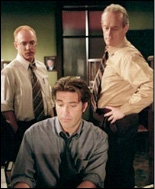|
Life on the Court
by Taunya Lovell Banks
Barely one year after the United
States Supreme Court ended the 2000 presidential election controversy
in Bush v. Gore, there are two programs about the Supreme
Court on commercial television. The latest addition, The Court,
starring Sally Field as Justice Kate Nolan, comes from the producers
of the critically acclaimed The West Wing. ABC decided
to air The Court as a temporary replacement for its new
lawyer show, Philly. The network probably reasoned that
The Court was a natural for a slot already devoted to
law and lawyering. There was, however, very little law or lawyering
depicted in the first show.
 The opening episode, entitled, Life
Sentence, has double meaning, signifying both the life prison
term of Charlene Grissom (Cynthia Ettinger), a woman career criminal
whose case is before the Court, and the life term of Supreme
Court Justices. The first part of this episode uses the Court
appointment process to disclose aspects of Kate Nolan’s
character. Nolan, a middle-aged state governor with a supportive
husband, is politically shrewd, yet impartial and ethical. Her
deft maneuvering through the appointment process suggests that
she will be the swing vote on an ideologically divided Supreme
Court. This fictionalized Court seems divided over the same hot-button
issues – abortion, the death penalty and three-strike criminal
laws– as the real Supreme Court. The opening episode, entitled, Life
Sentence, has double meaning, signifying both the life prison
term of Charlene Grissom (Cynthia Ettinger), a woman career criminal
whose case is before the Court, and the life term of Supreme
Court Justices. The first part of this episode uses the Court
appointment process to disclose aspects of Kate Nolan’s
character. Nolan, a middle-aged state governor with a supportive
husband, is politically shrewd, yet impartial and ethical. Her
deft maneuvering through the appointment process suggests that
she will be the swing vote on an ideologically divided Supreme
Court. This fictionalized Court seems divided over the same hot-button
issues – abortion, the death penalty and three-strike criminal
laws– as the real Supreme Court.
Justice Nolan, who replaces
a woman Justice killed in an automobile accident, joins a Court
that reflects racial and gender diversity as well. There is a
black woman, Justice DeSett (Diahann Carroll), and a Hispanic
man, Justice Martinez (Miguel Sandoval); all that is missing
is an Asian-American Justice. As with the real Supreme Court,
however, white men dominate.
The story line for the first
episode seems to overflow with coincidences and storylines. The
writer, Carol Flint, who worked on shows like ER, China Beach
and LA Law, is capable of doing better writing. She seems
unclear about whether this is a show about the Supreme Court
or the news media’s coverage of the Court. There is Harlan
Brandt (Craig Bierko), the lawyer-turned-investigative-reporter,
who seems intent on digging up dirt on Justice Nolan. Coincidentally,
Brandt was a student in a law school seminar taught by Justice
Nolan. He earned an “A” but Nolan told him that he
would never be a good lawyer. Brandt’s role and motives
are unclear. Does he have a personal beef with Justice Nolan,
or does he simply represent those unsavory scandal mongers who
masquerade as news reporters?
In the meantime, Brandt is
doing a feature portraying Justice Nolan as the mirror image
of Charlene Grissom, the career criminal. Once on the Court,
Grissom’s life sentence is the first case for which Justice
Nolan must cast a vote – more coincidences. The legal issue
raised by Grissom’s case, the harshness of three-strikes
laws, only serves as a background for the personal stories of
the Justices and their law clerks. Unfortunately, West Wing
does a better job than The Court of interweaving its
many story lines in more credible fashion. Yet The
Court is a much more respectful depiction of the Supreme
Court than CBS’s First
Monday.
All told, there are good and
bad aspects about The Court, as well as its less notable
competitor, First Monday. Both shows purport to give television
viewers insights about the United States Supreme Court and the
Justices. This is a good thing, given the general public’s
lack of knowledge about the Court. Yet each show gives viewers
a distorted view that is not subject to correction, since the
real Supreme Court remains shrouded in mystery, consistently
refusing to even televise its oral arguments. As a result, after
viewing regular doses of The Court and First Justice,
many Americans may be more familiar with the fake Justices than
the real Justices. This would be a bad development.
Television, a constant presence
in many American households, increasingly tends to blur the distinctions
between reality and fiction. Unclear is whether public exposure
to only a fictionalized view of the Supreme Court will pose a
threat to this institution’s reputation and prestige. On
the other hand, The Court and First Monday may
simply reflect an already alienated public’s view of the
United States Supreme Court. Perhaps the Court, when it decided
Bush v. Gore, did more harm to its own reputation than
two television series can. Only time will tell.
Posted April 3, 2002
|